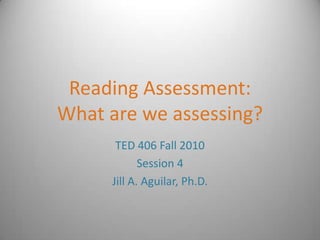
Ted406 session 4
- 1. Reading Assessment:What are we assessing? TED 406 Fall 2010 Session 4 Jill A. Aguilar, Ph.D.
- 2. We can be assessing… READERS, TEXTS, CONTEXTS, CONTENT…
- 3. Secondary Texts Secondary texts are often more difficult than elementary texts for 2 main reasons: 1 the vocabulary, concepts, and “readability” (estimated grade level= length of words, number of words per sentences, number of sentences per paragraph) are higher than students are comfortable with, and 2 they are typically written in expository, rather than narrative style.
- 6. A few points about assessment…
- 7. 1. Assess what you intend to assess. Often teachers assess reading skills when they want to assess content knowledge, and content knowledge when they want to assess reading skills. Ask, will the results of this assessment tell me how well my students read, or how much and what they know about [algebra]?
- 8. 1. Assess what you intend to assess. What are you assessing? Prior knowledge about a topic you plan to teach Reading knowledge and skills in English Studying knowledge and skills in English Skills in reasoning and logic Attitudes toward school Experience and knowledge about taking standardized tests Knowledge about a topic you are presently teaching Knowledge and skills acquired from a unit you have finished teaching Knowledge and skill acquired from your course by the end of the year
- 9. 2. Once you have identified your target, state your purpose. For what purpose(s) are you assessing? Formal (valid & reliable) v. Informal (may or may not be valid and reliable) Valid- assesses what it purports to assess Reliable- assesses various groups at different times in the same way Survey (a snapshot; may be used before, during, after teaching) Formative (the teaching is still teaching the topic) v. Summative (the teacher is done teaching that topic) Criterion-Based (everyone can score 100%) v. Standardized (follows a normal curve)
- 10. 3. Once you have assessed,analyze your assessment. If it was worth assessing, it is worth analyzing. What do these data mean? What are their implications for your next steps in instruction? Faculty-wide: Analyze school-wide CST data Departments: Analyze departmental CST data SLC’s, Cores, etc.: Analyze the longitudinal data for your students Teachers: Analyze your pre-assessment, checks for understanding, other formative assessments, and your summative assessments.
- 11. 3. Once you have assessed,analyze your assessment. Teachers, Ask: Where are your students now? How far have they come? What has been easy? What has been difficult? Why? Where should they go next? How should they get there?
- 12. The MOST VALUABLE TYPE OF ASSESSMENT FOR TEACHERS IS… Ongoing, informal assessment that matches the types of learning activities that students have been engaged in…
- 13. Principles of assessment Procedures and instruments must be content specific; Easily constructed and scored; Group administered; Representative of the types of reading skills that students would be expected to use in their science, history, or other subject area classes
- 14. For Task 1 you want to know how your students can be expected to interact with and perform in specific subject matter materials in order to make appropriate instructional decisions.
- 15. Types of assessments inRakes & Smith: Surveying Content Area Reading Interests Background Knowledge and Reader Interest Surveys help the teacher evaluate student interest, attitude, and prior knowledge. Open-ended projective Structured, paired choice Summated or agree/disagree Semantic differential
- 16. Types of assessments inRakes & Smith: Group Reading Inventory Especially useful for courses that are textbook-dependent like Social Studies, Science, and Math. Part One—Using Book Parts Part Two—Silent Reading
- 17. Types of assessments inRakes & Smith: Cloze Inventory Helps tell which students can and cannot read the book from which the Cloze Inventory is taken; how good is the match between students and text? Independent Level (96-100%): Student can read text on her/his own and comprehend without instruction Instructional Level (90-95%): Student can comprehend the text with assistance Frustration Level (-94%): Student requires more assistance than is practical; the text is probably too difficult
- 18. Types of assessments inRakes & Smith: Interactive Assessments (more appropriate over time) Checklists Interviews Portfolios